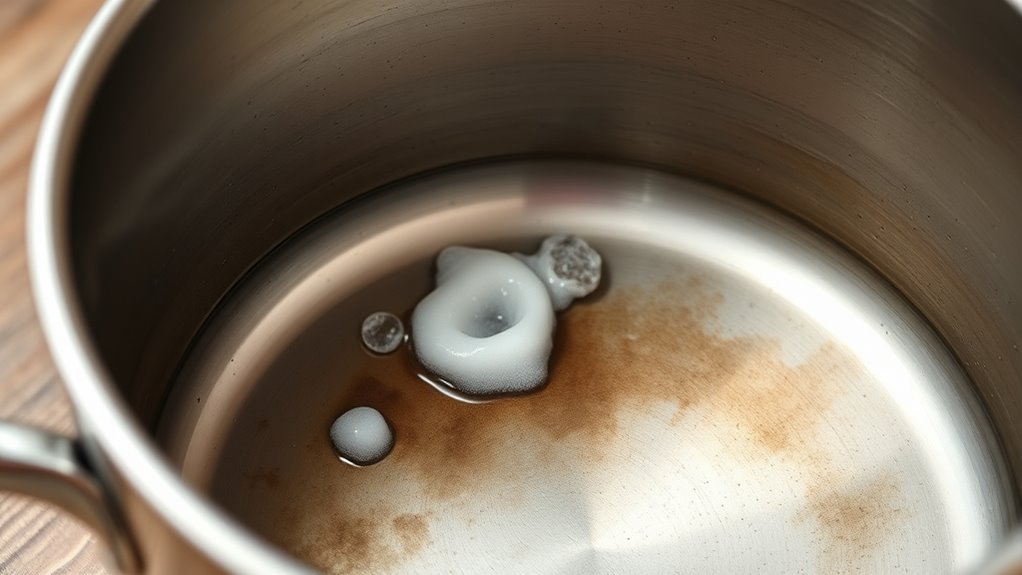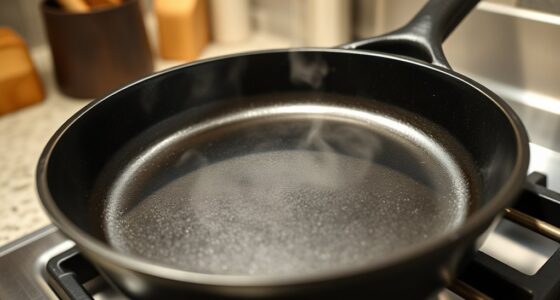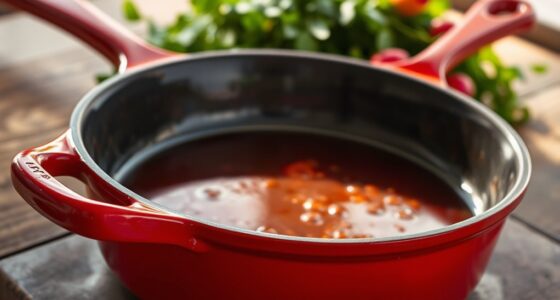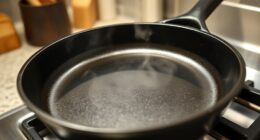To clean burnt pots without scratches, use gentle methods like soaking with hot water and baking soda, which helps loosen residue safely. Apply a baking soda paste directly to stubborn spots, then gently scrub with a soft sponge or cloth—avoid abrasive tools like steel wool. For extra cleaning power, add a splash of vinegar to create fizzing action that lifts grime without damaging your cookware. Continue with these safe tips to keep your pots spotless and scratch-free.
Key Takeaways
- Use a soft sponge or cloth with baking soda paste to gently scrub burnt areas.
- Avoid steel wool or harsh scrub brushes to prevent scratching the cookware surface.
- Soak the pot in hot water with baking soda to loosen burnt residue before cleaning.
- Add a splash of vinegar to create a fizzing reaction that lifts grime safely.
- Rinse thoroughly and dry with a soft towel to prevent water spots and maintain surface integrity.
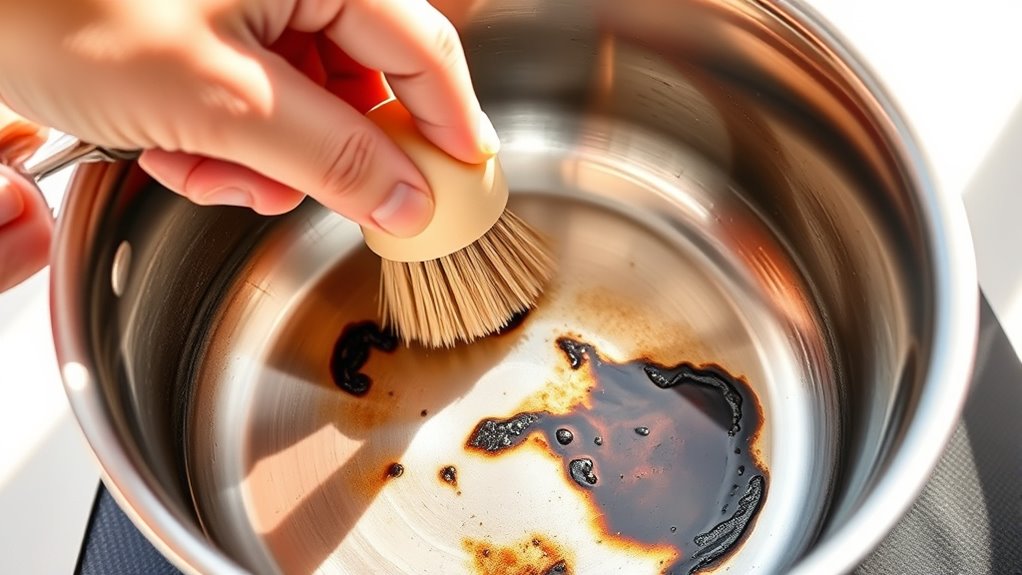
Burnt pots can be frustrating to clean, but with the right methods, you can restore them to their original shine. When tackling stubborn stains without scratching the surface, eco friendly cleaning options are your best bet. One effective approach involves baking soda techniques, which are gentle yet powerful enough to lift burnt-on residue without damaging your cookware. Baking soda is a natural, non-abrasive cleaner that’s safe for most pots and pans, making it an ideal choice for environmentally conscious cleaning.
To start, fill your burnt pot with hot water, enough to cover the affected area. Add a generous amount of baking soda—about a few tablespoons—and stir it in to dissolve. Let this mixture sit for 15 to 30 minutes, giving the baking soda time to loosen the burnt residue. For particularly stubborn stains, you can create a thick paste by mixing baking soda with a small amount of water. Apply this paste directly onto the burnt spots, spreading it evenly with a soft cloth or sponge. Let it sit for another 15 minutes to allow the gentle abrasive properties of baking soda to work on breaking down the burnt material.
Fill the pot with hot water, add baking soda, and let sit to loosen burnt residues.
Next, use a non-abrasive scrubber or a soft sponge to gently scrub the area. Avoid steel wool or harsh scrub brushes, which can scratch your cookware’s surface. Instead, rely on the mild abrasiveness of baking soda to lift the stains without damage. If necessary, add a little more baking soda along with a splash of water to create a gentle paste that enhances scrubbing power. Rinse thoroughly with warm water to remove any residue, then dry with a soft towel. This method guarantees your pots stay scratch-free while achieving a thorough clean.
For extra eco friendly cleaning, you can also add a splash of vinegar to the baking soda solution. The chemical reaction creates fizzing action that helps lift even more stubborn burnt-on grime. Just pour a small amount of vinegar into the hot water before adding baking soda, then follow the same soaking and scrubbing process. This combination is not only effective but also free of harsh chemicals, making it safe for your family and the environment. Regular use of baking soda techniques can prevent heavy build-up, making future cleaning easier and prolonging the life of your cookware.
Frequently Asked Questions
Can I Use Steel Wool on Non-Stick Pots?
You shouldn’t use steel wool on non-stick pots, as it can scratch and damage the coating. Instead, opt for softer cleaning tools like a non-abrasive sponge or a nylon scrubber. For tough stains, soak the pot in warm soapy water first, then gently scrub. Using steel wool on non-stick surfaces risks ruining the coating, making your pots less effective and harder to clean in the future.
Are Natural Remedies Safe for All Types of Cookware?
Yes, natural remedies are generally safe for most cookware types, but you should always check for specific cookware compatibility. Some natural ingredients, like vinegar or baking soda, can cause unwanted chemical reactions if used on certain materials, such as aluminum or uncoated cast iron. Always test a small area first and follow manufacturer instructions to avoid damaging your cookware or affecting its safety and performance.
How Often Should I Clean Burnt Pots to Prevent Buildup?
You should clean your burnt pots regularly, ideally after each use, to prevent buildup. Incorporate seasonal cleaning and preventative maintenance to keep them in top shape. Skipping routine cleaning can lead to stubborn burns that are harder to remove. By staying consistent, you avoid damage and keep your cookware looking new. Think of it as a small habit that pays off in the long run, saving you effort and extending your pots’ lifespan.
What’s the Best Method to Remove Stubborn Burnt Residue?
To remove stubborn burnt residue, start by using a scraper tool gently to lift off loose bits. Then, fill the pot with water and add a few drops of chemical cleaner or baking soda. Let it sit for a while to loosen the burn marks. For tough spots, reapply the cleaner and scrub softly. Always rinse thoroughly to avoid residue and scratches, keeping your pot in good shape.
Can Cleaning Methods Damage the Pot’s Coating or Material?
Cleaning your pot is like steering a delicate dance—using harsh tools can cause coating damage or compromise material safety. To avoid this, stick to gentle, non-abrasive methods like baking soda paste or vinegar. These options clean effectively without scratching or harming the coating. Always check your pot’s instructions, and steer clear of steel wool or abrasive scrubbers that can damage the surface and reduce its longevity.
Conclusion
Now that you know how to clean burnt pots without scratches, you hold the key to restoring their shine and longevity. Think of your pots as silent witnesses to countless meals—treat them gently, and they’ll serve you well for years to come. Remember, patience and care transform a formidable task into a rewarding ritual. With these tips, you’re not just cleaning—you’re preserving culinary history, turning routine chores into acts of love for your kitchen.
